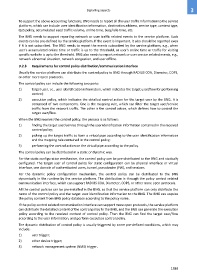Page 1399 - 5G Basics - Core Network Aspects
P. 1399
Signalling aspects 3
To support the above accounting functions, BNG needs to report all the user traffic information to the service
platform, which can include user identification information, destination address, service type, content type,
QoS policy, accumulated used traffic volume, online time, busy/idle time, etc.
The BNG needs to support reporting network or user traffic related events to the service platform. Such
events can be pre-defined by the service platform. If the event is important, it also should be reported even
if it is not subscribed. The BNG needs to report the events subscribed by the service platform, e.g., when
user's accumulated online time or traffic is up to the threshold, or user's online time or traffic for visiting
specific website is up to the threshold. BNG also needs to report network or user session related events, e.g.,
network abnormal situation, network congestion, and user offline.
D.2.3 Requirements for control policy distribution/communication interface
Usually the service platform can distribute the control policy to BNG through RADIUS COA, Diameter, COPS,
or other more open protocols.
The control policy can include the following two parts:
1) target user, i.e., user identification information, which indicates the target user/flow for performing
control;
2) execution policy, which indicates the detailed control action for the target user by the BNG. It is
composed of two components. One is the mapping rule, which can filter the target user/service
traffic from the network traffic. The other is the control action, which defines how to control the
target user/flow.
When the BNG receives the control policy, the process is as follows:
1) finding the target user/service through the user identification information contained in the received
control policy;
2) picking up the target traffic to form a virtual pipe according to the user identification information
and the mapping rule contained in the control policy;
3) performing the control action on the virtual pipe according to the policy.
The control policy can be distributed in a static or dynamic way.
For the static configuration mechanism, the control policy can be pre-distributed to the BNG and statically
configured. The target user of control policy for static configuration can be physical interface or virtual
interface, one domain of authenticated users, tunnel, pseudowire (PW), and sessions.
For the dynamic policy configuration mechanism, the control policy can be distributed to the BNG
dynamically in the runtime by the service platform. The distribution is through the policy control related
communication interface, which can support RADIUS COA, Diameter, COPS, or other more open protocols.
All the control policies can be pre-installed in the BNG, so that the service platform can only distribute the
name of the control policy and the target user identification information to the BNG. The BNG can acquire
the policy content from BNG policy database according to the policy name.
If the policy control related communication interface can support more open protocols, the service platform
can distribute the detailed content of the control policy to the BNG, and the BNG can generate the execution
policy according to the received content of control policy. Then the BNG can find the target user/flow
according to the user information, and perform execution control policy.
The dynamic distribution of control policy is usually triggered by some pre-defined conditions, which may
include:
1) user trigger;
2) other device trigger;
3) network management system (NMS) trigger.
1389

